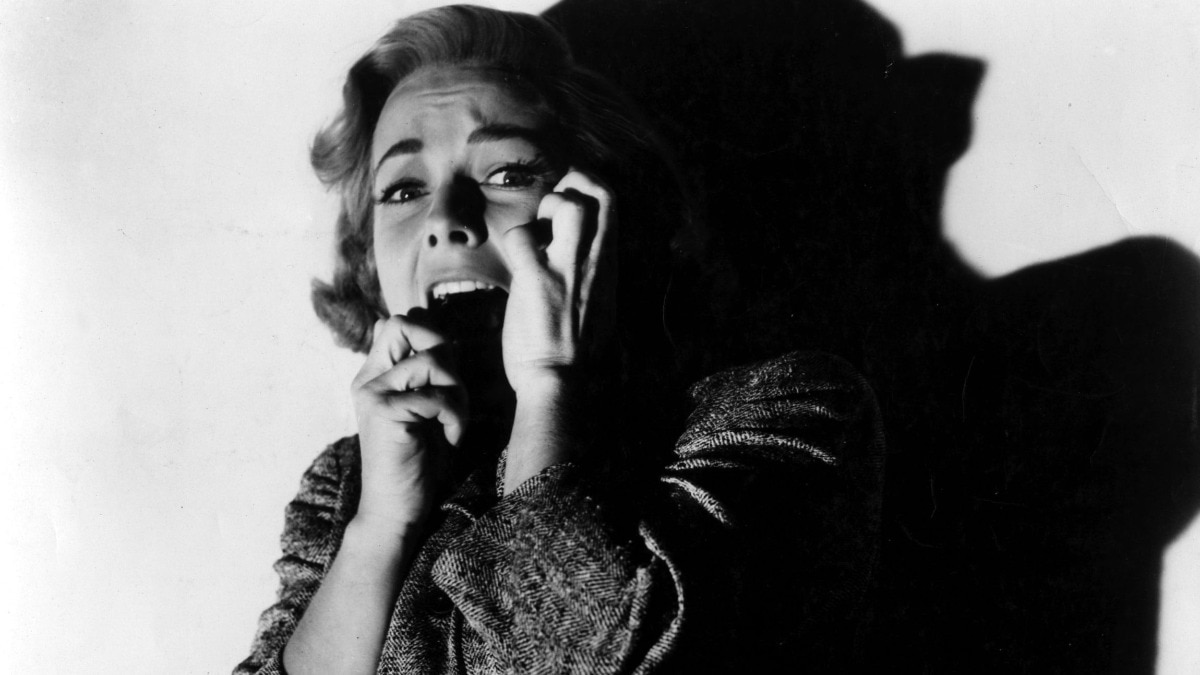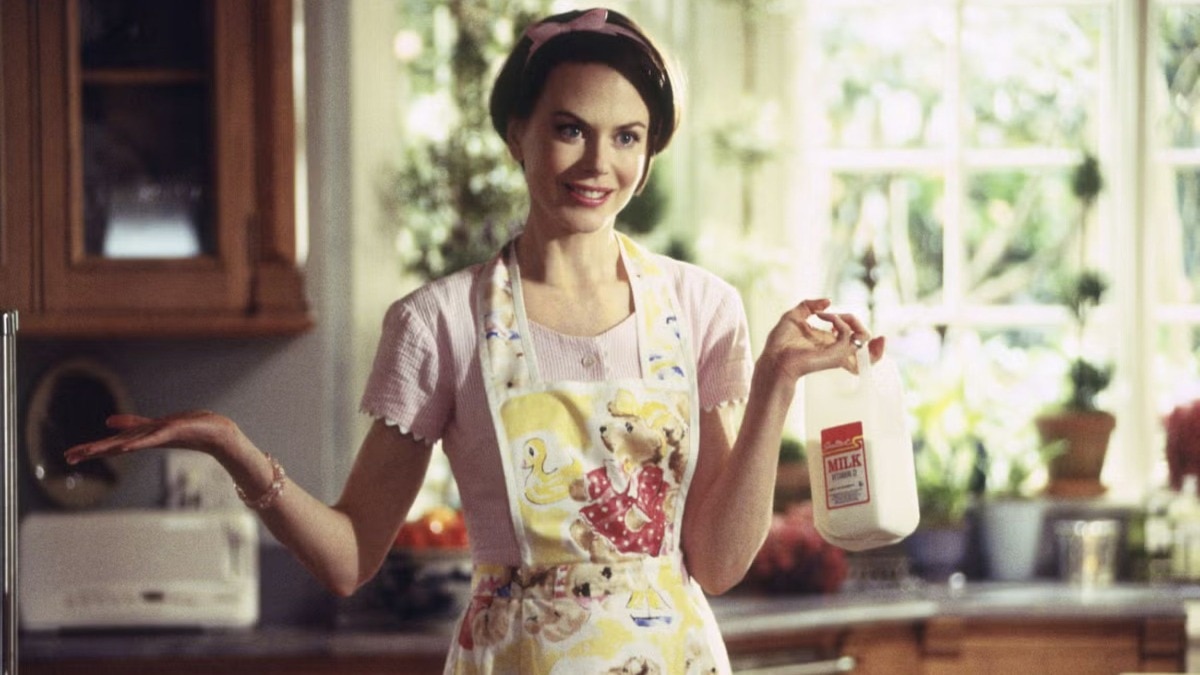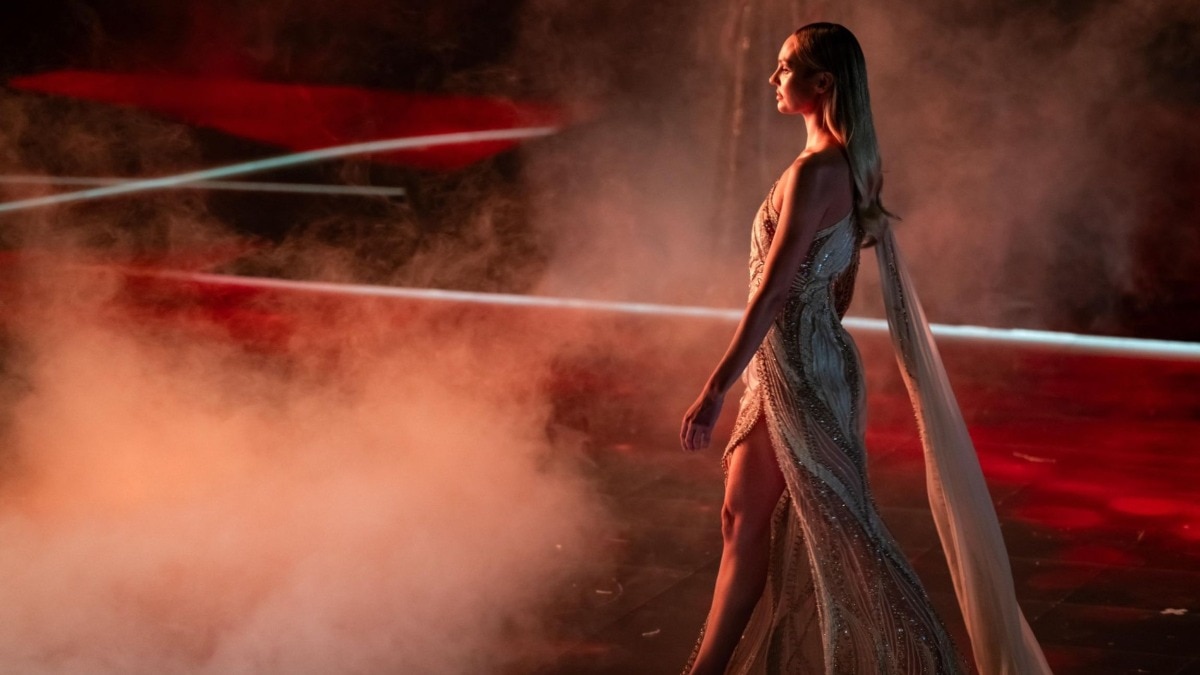
Lana Del Rey on what drives her, finding her authentic self, and more
She's one of the most influential songwriters of the 21st century and also one of the most misunderstood.



Lana Del Rey points a red vape at a set of lounge chairs in her backyard. “When I bought those,” she tells me, “I was stoked.” I’m skeptical. The chairs look untouched, unused. A telltale line bisects their fabric, marking where the fence has cast a shadow over half of the material. There, in perpetual shade, the vibrant green pattern is preserved, but above it the fabric is exposed, bleached by the sun, nearly to white.
“We had a firepit,” Del Rey says, gesturing first to a place in the yard that doesn’t seem to have ever had a firepit and then to a dilapidated daybed. “Despite its state, this daybed, I’m proud of this,” Del Rey tells me. “I got it from Living Spaces. They brought it in the morning and assembled it by four. That’s amazing.”

Is it? I wonder. Is this quick assembly of a now waterlogged and forgotten daybed amazing to Lana Del Rey, one of the most successful and influential singers, songwriters, and forces in popular music over the past decade? Some of my doubt manifests in relation to her house, which seems more set design than home, conceived to persuade me that I’m in the presence of the world’s most down to earth multimillionaire.
To be clear, this house is charming. I can only describe it as unassuming, with a small yard of yellowing grass. But it is also exceedingly modest for a woman of Del Rey’s fame and resources. The home is comfortable, clean, and simply adorned. There’s little in the way of decoration other than a magazine cutout of Marilyn Monroe tacked to a window in the bathroom and a few pictures of family. Her brother, Charlie, uses a sunny room in the back as his office, and their sister, Caroline, is over often. “We process things as a family,” Del Rey says, speaking to her bond with her siblings. “It’s never alone. Some nights it’s alone, but not really. We’re on the same page. We’re always on the same page.”

Del Rey, too, is simply adorned in slim jeans, a plain sweater, and ballet flats. Her long brown hair is neatly brushed, and her face is free of make-up aside from a slight and delicate winged eyeliner—the only visual connection to the femme fatale look of her professional life. Her speaking voice is soft and lilting. She offers me a Diet Coke, a Red Bull, and a coffee, the last of which has just finished percolating in the same kind of $30 coffee maker I had in my college dorm room. Del Rey gathers up all three beverage options for herself, along with her red vape pen, and leads me outside. The steps to the patio are broken.
At this stage, Del Rey is generally considered to be one of the most accomplished songwriters of her generation—or as some people, like Taylor Swift, have offered, the best. Her 2012 major-label debut album, Born to Die, has spent more than 500 weeks on the Billboard 200 chart, a feat matched among women solo artists by only Adele. Del Rey followed up Born to Die with a succession of artistically varied and emotionally resonant music that stirred ever-increasing devotion in her fans. Her most recent effort, Did You Know That There’s a Tunnel Under Ocean Blvd., released this past March, may be some of her best work to date. It’s a sprawling, textured meditation on timeworn themes like love, family, loss, and longing.
But as I sit beside Del Rey in her backyard, taking in the house, the broken stairs, and the fading fabrics on chairs, the feeling of doubt that had been creeping up on me suddenly doubles. I know this feeling is not coming from the house alone; it’s likely more from the cultural residue of suspicion built up by critics who, in the early days, were quick to dismiss Del Rey as somehow inauthentic, a flashy faker whose career would flicker brightly and burn out. The doubt around Del Rey has long been proved to be unfounded.
I know this. And yet I still find myself searching for artifice and affect, for a peek beyond her persona to locate the space where some “realer” Del Rey is hidden. Isn’t this—for me, as a profiler—my assignment?
Luckily, my friend Kelly, a thoughtful and serious Del Rey fan, sets me straight. Del Rey, Kelly reminds me, shops at Kohl’s, gets awards-show dresses off the rack at the mall, and makes friends with workers at a Waffle House and starts serving people alongside them. Did You Know That There’s a Tunnel Under Ocean Blvd. is also up this year for five Grammys, including Album of the Year, to add to Del Rey's previous six nominations, and she has spent a third of 2023 on tour, headlining venues around the world. No single one of these truths negates or invalidates the authenticity of any of the others. “If you’re trying to understand her through some stiff binary of persona versus authenticity,” Kelly says, correctly scolding me, “you’ve already failed the assignment.”

So who is Del Rey beyond this binary?
“She’s unearthly suburban and unreasonably talented, and she can pretend to be a normal person,” the filmmaker and writer John Waters tells me. “I think of the ad campaign for Russ Meyer’s Lorna,” he says admiringly, referring to the 1964 sexploitation film. “(The tagline) could go for her: ‘Longing, love, lust, life, Lana. Too much for one man.’ ”
Director David Lynch is also a fan. “She tells a story in her music,” Lynch says. “She gives a mood and a story and a way to think, and she paints a picture in your brain.”
Legendary singer-songwriter and activist Joan Baez says that the first thing that comes to mind when reflecting on her friendship with Del Rey is Del Rey’s generosity. Del Rey, Baez recalls, once gave Baez’s granddaughter, who was cold, the jacket off her back, gifting it to her permanently after signing the sleeve. Baez also admires Del Rey’s sense of humour. Once at a lunch together, Del Rey was struck with “a laughing fit,” says Baez. “And she flattened herself out on her back on two chairs, just with her head kind of locked over the back of the chair, just laughing, just giggling and putting us all in the giggles. … She’s delightful. That’s a good word for her, among other things.”
“I’m definitely not in love right now. … But give it a week. My history, sure, it’s coming for me.”
But my favourite story about Del Rey comes from her trusted clairvoyant Tessa DiPietro, whom Del Rey sees weekly. The two had attended a guided meditation together and were sitting in a circle with others when the leader asked them all to imagine the shape of their thoughts. “It was very kind of heady,” DiPietro says. “I think people felt there was this tension in the room to have the right answer to ‘What are the shape of my thoughts?’ And people are saying stuff like, ‘Well, my thoughts look like clouds.’ And somebody else will go, ‘Well, my thoughts look like little bubbles.’ And we come around to Lana, and she’s looking into space and thinking, and then she says, ‘Men. My thoughts are all shaped like men.’ It was so perfect because you couldn’t tell if she was being ironic or not. And yet it was the most truthful answer anybody had given.”
Del Rey was born Elizabeth Woolridge Grant and grew up in Lake Placid, New York. She released music first under her own name, as Lizzy Grant. But when that failed to chart, she chose a stage name and a new look - one that pulled from the iconography of doomed beauty, a pastiche of pinup bombshell and gangster’s girlfriend. She was Marilyn Monroe, Lana Turner, Priscilla Presley, Karen Black in Easy Rider. Her videos were a collage of images signaling the American dream gone wrong: blinking neon, leaves in the swimming pools, death and love and sex displayed before the flag. Was it one reference too many? Stage names, symbolism, and reinvention are nothing new to music. Yet in Del Rey’s case, some people felt inexplicably tricked.



Upon its release, Born to Die was widely critically panned. The New Yorker said that the “Del Rey character is a combination of disaffected and cynical and romantic and brutal and naïve, which makes her sound more forgetful than profound.” The New York Times reduced Del Rey to a mere “pose, cut from existing, densely patterned cloth” and diagnosed her career as “founded on bad faith all around.” Pitchfork rejected Born to Die as “out of touch,” not just with the world but also with “the simple business of human emotion,” slamming it in the closing line of the review as “the album equivalent of a faked orgasm.”
Audiences disagreed. Catapulted by the success of singles like “Video Games,” “Blue Jeans,” and “National Anthem,” Born to Die became the fifth highest selling album in the world in 2012.
Del Rey, though, was hurt. “I think in one week, The New Yorker, The New York Times, The New York Post, and New York magazine agreed that it was the most ridiculous act that had ever come out,” she says. But she rode the disorienting waves of critical rejection and commercial success in the best possible fashion: by simply continuing to write songs. “That may have been just pure ‘Let’s try and make this work!’ energy,” she says. “I’m sure my intuition in my everyday life was still pretty strong. But with the career, I think it was like ‘Let’s just try and see if we can make this work’ instead of having it come to a brutal end.”
“I’m sure my intuition in my everyday life was still pretty strong. But with the career, I think it was like, ‘Let’s just try and see if we can make this work.’”
Interestingly, Del Rey credits this period with gifting her a unique opportunity for self-reflection. When critics called her inauthentic, she sought to understand what it was they were seeing and why it differed from how she felt. “It was 100 per cent authentic,” she says of her Born to Die reinvention. “It’s just that where I was at the time was malleable in my own life - easy to, like, acquiesce,” she explains. “I kept rereading the idea of somebody who was feigning vulnerability,” she says. “(But) perhaps what they saw was what was vulnerable.”
Critics have retrospectively hailed Del Rey as a singular and pioneering talent whose influence is evident in the work of artists like Billie Eilish and Olivia Rodrigo—including Pitchfork, which ran a new review of Born to Die nearly a decade after the first one, writing, “Lana is reaching for something: the fulcrum point where the fear and pain of sexualization start to work as leverage.” It reaffirms, even though she has nothing left to prove, that those who foresaw her career as a mere cultural blip were—well, Del Rey puts it best: “It’s almost like they were wrong,” she says. “That’s all. They just got it all wrong. That’s all.”
When I ask Del Rey how she processes just how far her career has come, her face lights up. “We’re famous down in Arkansas,” she says, beaming. Something magical happened there recently. She had been booked to play the Walmart amphitheater in Rogers, and the show had sold out in hours, leaving many fans who’d been waiting in the online queue to buy tickets out of luck. Del Rey hadn’t expected to have such a fan base in Arkansas, and so she was shocked when a waitress at a tavern she visited after performing showed her a screenshot of the queue. The waitress had been number 80,000.
“When I saw that, that’s when I knew—it’s the moment,” Del Rey tells me. The defining moment for you? I ask her. “Yeah, for sure. Absolutely.” Really? Out of everything? “Anything that’s ever happened in my whole life,” she says definitively. “That’s it.”

Why was this moment in Arkansas so meaningful to Del Rey? Well, in a way, it seems to all come back to this little house, which has become, for Del Rey, a kind of “accidental” litmus test. “We had some fights over this house, a couple people,” Del Rey says. “They didn’t get it.”
One person who didn’t get it was a boyfriend. “I feel like even the most chill guy doesn’t really want to chill here,” Del Rey says. “Sadly, part of you knows … that ain’t it. … That one shocked me. I won’t name names and whatever, but that one really shocked me, that person. That was actually the end of a relationship.”
He had wanted more from her, from her house maybe? But what had he wanted? And what had I, too, expected? An idea of her, but not actually her. “That’s a tough nut to swallow,” she says, her words dissolving into the warm evening air. “In that person’s case,” she says, referring again to her ex, “there was something going on with them, like a little bubble ego. See, I don’t get to have one anymore. It’s been smashed to … what do you call it? Smithereens. I’m sure it’s somewhere in my toe. That’s it. I’d love to grow one. I’m learning how. I’m learning,” she says. “I know what I want.”
I, too, am failing her litmus test as I continue to wonder if the modesty of this house constitutes yet another brick in the wall of her persona. Why do I keep digging then for some sort of ulterior motive or proof of deception? Why do I struggle to take her at her word? Do I feel an entitlement that stems from the journalists who’ve come before me to demand she perform some version of authenticity they deem recognisable?
“I won’t name names and whatever. But that one really shocked me, that person. That was actually the end of a relationship.”
I am not the first or last to perceive her with quizzical suspicion. But the people in the queue in Arkansas? The waitress at the tavern? Del Rey received from them only acceptance and appreciation. Would they take her at her word? Would they love this house and everything in it? Would they want to chill with her here? Yes, she feels they would. “That’s it,” she affirms when I suggest this connection. “And that sums it all up with a period.”
The simplicity of the house is perhaps in line with the simplicity of Del Rey’s current desires, which are few. She isn’t sure she wants anything at all, and this, she told a friend recently, has come with its own set of challenges. “I don’t think it’s because I’ve done everything. I just don’t want, really. I thought about it all day, two days ago. Bugged me. I just couldn’t think of anything. And it wasn’t in the way, like, ‘Thou shalt not want for anything!’ It wasn’t like that. It was more just like I couldn’t think of anything. And (my friend) said, ‘Well, what if you whipped up your wildest desire?’ And I was like, I just couldn’t even whip something up journaling. So, I don’t know. But I have wanted things in the past really strongly.”


I ask her what she’s wanted most before, and she demurs, “I don’t know if I would say.” What about love? I wonder. I ask her if she’s in love right now. “I’m definitely not in love right now. No,” she says firmly, smiling. “Absolutely not in love. Have been, but no.” But is it something she wants? I ask. She shrugs. “Well, I’ll tell you. It hasn’t crossed my mind in the last five months on the road or here yet. But give it a week. My history, sure, it’s coming for me at some point. Yeah. It would be interesting if it didn’t. It would be interesting if it didn’t.”
Can you imagine that life without commitment to romantic love? I ask her. “I don’t know,” she says, then mulls over the question for a moment. “I think I would have to get my orientation toward where I want to be geographically stronger in my solar plexus, like a knowingness there, before I could tune into a stronger desire romantically. Because if you don’t feel a connection necessarily to the pavement you’re walking on, the love thing stays over there,” she says, waving out toward a world beyond her yard.
Regardless of where she lives and what others make of it, Del Rey’s strongest sense of place and belonging remains within herself. “I have a big old home inside,” she says. “That’s the whole thing. It’s warm in here. There’s a huge hearth in here. If I had to peer right inside my heart, it’s really big. And it’s really hot and warm. But it can be icy though,” she warns me. “I’m not afraid of a fight. I’ll go from zero to 100 real fast, but that’s what you can do when you’re at home with yourself. You can fight fast, love fast, all that stuff.”

“It’s inconvenient to be in touch with yourself,” she says gently. “It really is.”
I look again at the lounge chairs Del Rey adores. There they are, out in the open, half obscured, half exposed. Shadow is not deception. It just is a place we cannot see into as easily.
We sit outside in the waning dusk, talking on and on until night has fully descended around us. There are no patio lights. Occasionally, Del Rey waves awake a motion detector lamp with a flail of her arms and a hard beam blinks on, shining directly into my eyes, rendering them useless, then blinks off seconds later, leaving us again in total darkness.
This doesn’t bother Del Rey. She does not mind the shadows, nor does she hide herself within them. It’s my struggle, alone, to see.











